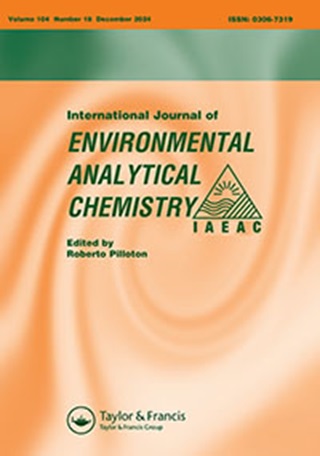Sol-gel immunoaffinity chromatography for isolation of deoxynivalenol and zearalenone from food and environmental samples
IF 2.5
4区 化学
Q3 CHEMISTRY, ANALYTICAL
International Journal of Environmental Analytical Chemistry
Pub Date : 2023-10-24
DOI:10.1080/03067319.2023.2269856
引用次数: 0
Abstract
ABSTRACTThe presence of mycotoxins in food is a significant concern due to their potential health risks. It is estimated that around 25% of global food production is contaminated with mycotoxins, which can be produced by certain types of fungi that infect crops during different stages of growth. As a result, it is crucial to monitor mycotoxins in food sources and develop effective methods for removal or reduction. One technique commonly used for detecting and separating mycotoxins is immunoaffinity chromatography (IAC). Traditionally, IAC uses antibodies covalently bonded to a solid support material, but this can lead to conformational changes and reduced affinity towards the analytes. To address these limitations, researchers have explored alternative methods for immobilising biomolecules, such as the sol-gel method, which involves encapsulating biomolecules within the pores of a glass matrix. This approach makes it easier to reuse the immunoaffinity columns and reduces the need for bacteriostatic agents, making the process more cost-effective and efficient. The results showed that sol-gel IAS was able to effectively separate these toxins from complex matrices, demonstrating its potential for widespread application in food safety monitoring. Additionally, the ability of sol-gel IAS to remove mycotoxins from environmental samples tested was highlighting its versatility and potential for broader applications beyond food safety. Finally, they demonstrated the compatibility of sol-gel IAS with high-performance liquid chromatography, enabling online coupling of the two techniques for improved efficiency and accuracy. The findings of this study suggest that sol-gel IAC is a promising method for the detection and separation of mycotoxins in various matrices, including food, environmental samples, and other biological fluids. Its advantages over traditional IAC methods make it an attractive option for large-scale analysis and monitoring of mycotoxins in diverse settings.KEYWORDS: Sol-gel immunoaffinity chromatographydeoxynivalenolzearalenonefood and environmental samples Disclosure statementNo potential conflict of interest was reported by the author.溶胶-凝胶免疫亲和层析法分离食品和环境样品中的脱氧雪腐菌烯醇和玉米赤霉烯酮
摘要食品中真菌毒素的存在引起了人们的极大关注,因为它们具有潜在的健康风险。据估计,全球约25%的粮食生产受到真菌毒素的污染,这些毒素可由某些类型的真菌产生,这些真菌在作物生长的不同阶段感染作物。因此,监测食物来源中的真菌毒素并制定去除或减少真菌毒素的有效方法至关重要。一种常用的检测和分离真菌毒素的技术是免疫亲和层析(IAC)。传统上,IAC使用与固体支撑材料共价结合的抗体,但这可能导致构象变化和对分析物的亲和力降低。为了解决这些限制,研究人员已经探索了固定生物分子的替代方法,例如溶胶-凝胶法,该方法将生物分子包裹在玻璃基质的孔隙中。这种方法可以更容易地重复使用免疫亲和柱,减少对抑菌剂的需求,使该过程更具成本效益和效率。结果表明,溶胶-凝胶IAS能够有效地将这些毒素从复杂的基质中分离出来,显示了其在食品安全监测中的广泛应用潜力。此外,溶胶-凝胶IAS从所测环境样品中去除霉菌毒素的能力突出了其多功能性和在食品安全以外的更广泛应用的潜力。最后,他们证明了溶胶-凝胶IAS与高效液相色谱的兼容性,使两种技术能够在线耦合,以提高效率和准确性。本研究结果表明,溶胶-凝胶IAC是一种很有前途的方法,用于检测和分离各种基质中的霉菌毒素,包括食品、环境样品和其他生物液体。与传统的IAC方法相比,其优势使其成为在不同环境下进行真菌毒素大规模分析和监测的有吸引力的选择。关键词:溶胶-凝胶免疫亲和层析羟基雪腐菌烯丙烯酮食品和环境样品披露声明作者未报告潜在利益冲突。
本文章由计算机程序翻译,如有差异,请以英文原文为准。
求助全文
约1分钟内获得全文
求助全文
来源期刊
CiteScore
5.90
自引率
7.70%
发文量
373
审稿时长
4.4 months
期刊介绍:
International Journal of Environmental Analytical Chemistry comprises original research on all aspects of analytical work related to environmental problems. This includes analysis of organic, inorganic and radioactive pollutants in air, water, sediments and biota; and determination of harmful substances, including analytical methods for the investigation of chemical or metabolic breakdown patterns in the environment and in biological samples.
The journal also covers the development of new analytical methods or improvement of existing ones useful for the control and investigation of pollutants or trace amounts of naturally occurring active chemicals in all environmental compartments. Development, modification and automation of instruments and techniques with potential in environment sciences are also part of the journal.
Case studies are also considered, particularly for areas where information is scarce or lacking, providing that reported data is significant and representative, either spatially or temporally, and quality assured. Owing to the interdisciplinary nature of this journal, it will also include topics of interest to researchers in the fields of medical science (health sciences), toxicology, forensic sciences, oceanography, food sciences, biological sciences and other fields that, in one way or another, contribute to the knowledge of our environment and have to make use of analytical chemistry for this purpose.

 求助内容:
求助内容: 应助结果提醒方式:
应助结果提醒方式:


